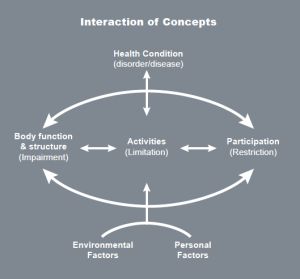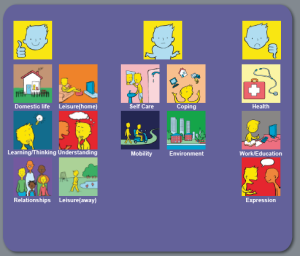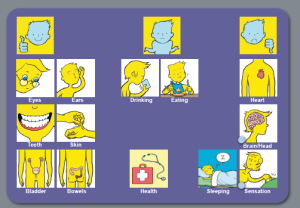The Health and Well-being resource is based on the WHO International Classification of Functioning, Disability and Health (ICF) which is a framework which covers almost every aspect of daily life and can be applied over different cultures (WHO 2001).
Use of the WHO ICF helps professionals to think holistically about the people they are working with. We have produced four sets of symbols, based on WHO ICF, to help people express their views about different aspects of their lives. These cover 13 topics:
You can use the symbols in different ways, depending on the cognitive abilities of the person you are working with. For example, if you are working with someone who can understand abstract concepts, you could start with the 13 main health and well-being symbols. Your top scale might be ‘managing’ and ‘not managing’. Here is an example of a mat completed by Duncan who had a stroke which affected his ability to communicate through speech:
Using these symbols as a starting point, Duncan could tell us that his main concerns related to worries about his health, expressive communication and work. From here, we did ‘sub mats’ to help Duncan identify the specific areas he wanted to work on/explore.
Here is the mat Duncan completed in relation to his health:
Having done this mat with Duncan, it became clear that he was worried about various aspects of his health, particularly the risk of having another stroke. The wider team were able to give him and his wife information about stroke prevention. Other mats were also completed, exploring expressive communication, work and education and higher level communication (which is included in the ‘learning and thinking’ topic, and covers written communication as well as memory and concentration). Using the Health and Well-being symbols, we were able to work with Duncan to help him identify the main issues that he wanted to work on and then work towards more specific rehabilitation goals. Duncan had copies of all the mats he had completed and found it useful to refer to them over the months. This helped everybody stay on track in relation to his goals and he was also able to track his progress over time.
Have a look at our Health and Well-being resource on our website. It is available both as an original Talking Mat with a physical mat and symbol cards or as a digital version as part of The Talking Mats pro subscription
During the final stages of developing Digital Talking Mats, we invited some people with aphasia and their partners to come and try it out for us. I spent some time talking to Matthew, who has severe global aphasia and dyspraxia. Matthew loves having a chat, but relaxed conversation can be a challenge because Matthew finds it difficult to generate language and sometimes his yes/no responses get mixed up. I used the ‘activities’ topic with Matthew to have a chat about the things he likes (and doesn’t like) doing. Matthew found the Digital Talking Mats easy to use and quickly gave me his views about activities. Using the i-pad made the conversation feel very natural, and Matthew was able to convey his sense of humour – when I asked him about Church; Matthew started to sing the Funeral March! We had quite a laugh about this, and it turned out that at the moment, Matthew really only goes to Church when there is a funeral. Matthew was also able to tell me about things that he finds difficult since his stroke, such as reading and doing DIY. During our conversation, I was struck by how equal the conversation felt. Matthew was able to express his views without feeling pressurised to think of words. I was able to ask Matthew open questions without worrying that I might not understand his responses. Using Talking Mats on the i-pad was easy and relaxed. I could imagine using it with Matthew to have a chat over coffee or at the pub. Perhaps we should think of some conversational symbol sets?
 Online training login
Online training login 







